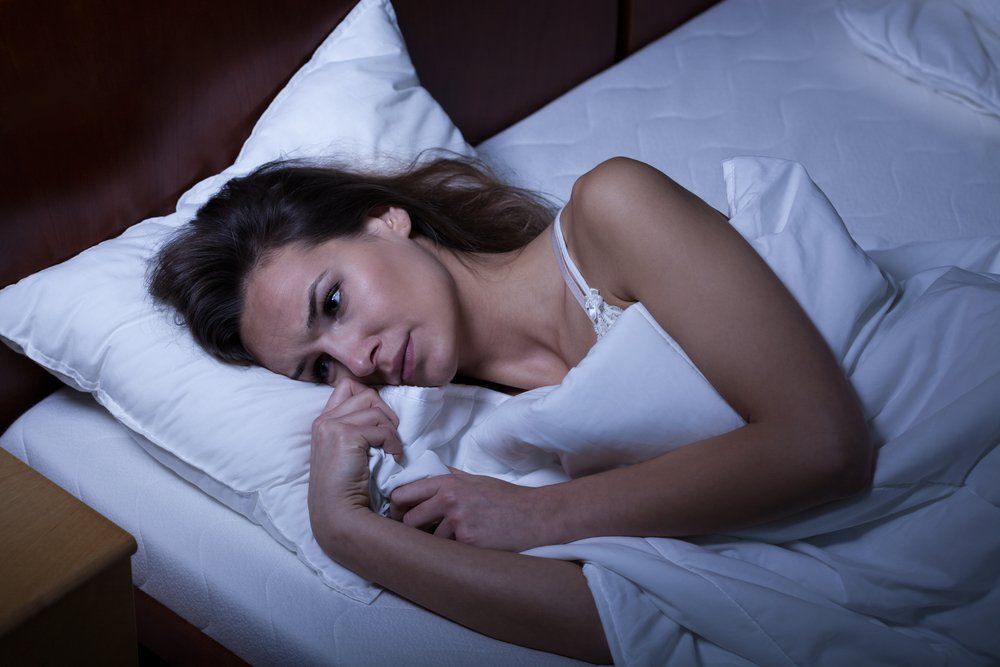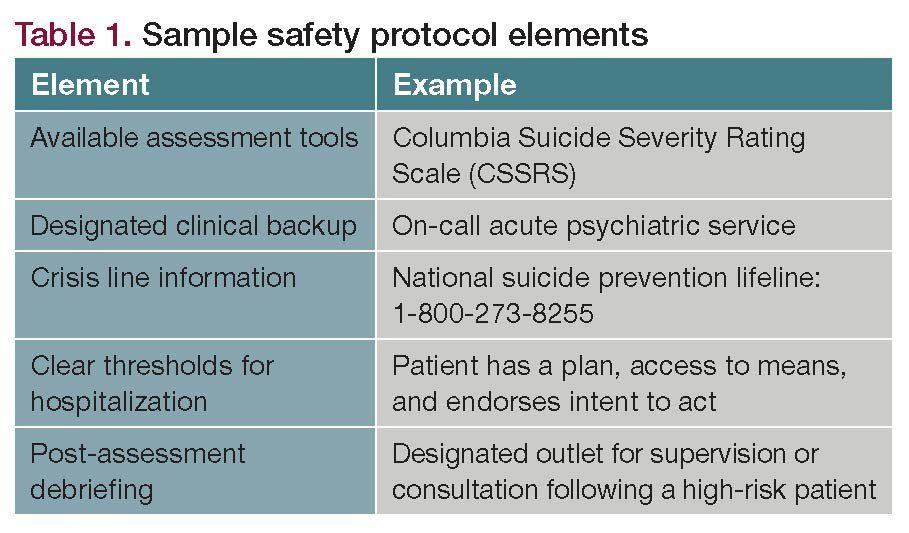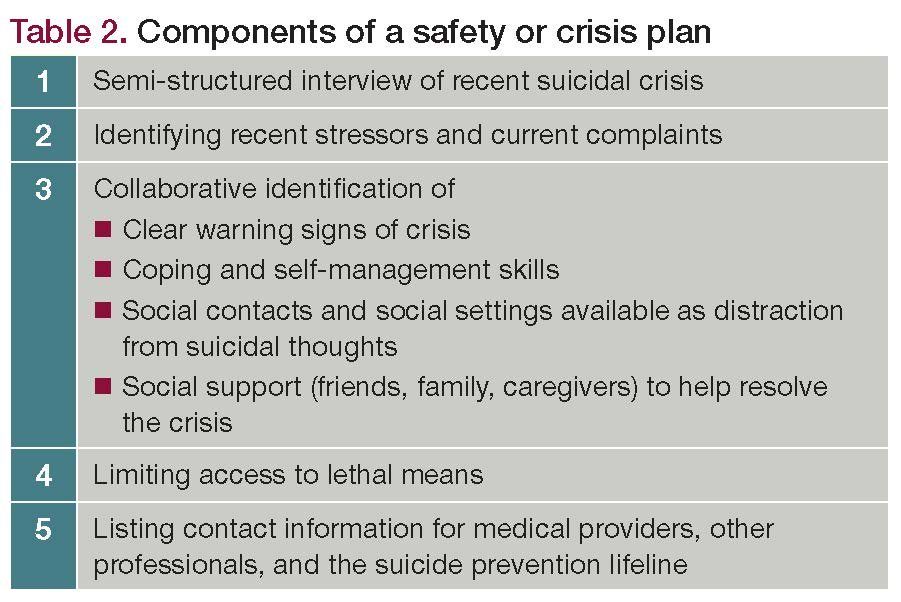Article
The Strong Relationship Between Sleep and Suicide
Author(s):
The steadily rising rate of suicide in the US is a vexing public health crisis. Among the many risk factors for suicidal thoughts and behaviors is sleep disturbance.

Significance for Practicing Psychiatrists

Table 1. Sample safety protocol elements

Table 2. Components of a safety or crisis plan

The steadily rising rate of suicide in the US is a vexing public health crisis. Between 2007 and 2017, suicide was the 10th leading cause of death, claiming the lives of nearly half a million people.1 It is perhaps even more striking that suicide is the fourth leading cause of death for individuals aged 35 to 54 as well as the second leading cause for those aged 10 to 34. Based on 2018 epidemiologic data, 1.4 million adults per year make a non-fatal suicide attempt and 10.4 million have serious thoughts of suicide.2 Among the many risk factors for suicidal thoughts and behaviors, one that consistently emerges as an independent risk factor is sleep disturbance (broadly defined) along with the specific sleep disorders of insomnia, nightmares, and sleep apnea.3,4
One reason that this sleep-suicide relationship is so important is that sleep disorders represent a modifiable risk factor. As noted a decade ago, several sleep medicine interventions can potentially make a difference in the lives of individuals who may be on a trajectory to suicide.5
It has yet to be firmly established if improving sleep actually reduces suicide. However, in a recent analysis of a large medical record study, it was observed that having a sleep medicine consultation was a protective factor for subsequent suicide attempts among those with a sleep disorder.6 There are also some indications that cognitive-behavioral therapy for insomnia (CBT-I) reduces suicidal thoughts.7,8
Mechanisms by which improved sleep may reduce risk are also putative. Indirectly, we can say with some certainty that sleep disorders (eg, insomnia, sleep apnea) are strongly related to the development and course of depression and their reversal improves mood. Other hypothesized mechanisms through which poor sleep may be associated with suicidal thought and behavior include increased impulsivity, emotional dysregulation, and impaired executive functioning, each of which may be reversed with improved sleep.
What, then, are actionable items for the clinician wishing to address the sleep-suicide relationship? We present three focal areas:
• Sleep disturbance screening
• Suicide assessment and safety planning
• Sleep treatment options in the suicidal patient
Given the high prevalence of insomnia in psychiatric populations and the ability of psychiatrists to fully manage insomnia (as opposed to sleep apnea), the primary focus of treatment options is for insomnia disorder.
Screening for sleep disorders
Often a sleep disturbance is identified in an initial psychiatric evaluation or in the normal course of a treatment episode by either a general screening question, “Do you have trouble sleeping?” or a direct patient complaint “My sleep is terrible.” We strongly recommend leveraging the use of standard depression screening tools to identify sleep complaints. For example, item 3 of the Patient Health Questionnaire-9, which probes for insomnia and hypersomnia has been found to be a good screen for clinically meaningful insomnia.9 An endorsement of 1 or higher on this 0-3 Likert-type scale item can be followed with questions to quickly assess for the possible presence of either of the two most common sleep disorders (ie, insomnia and sleep apnea).
Alternatively, the 7-item Insomnia Severity Index and the 8-item Stop-Bang Questionnaire can be used to assess sleep problems.10,11 Both are efficient and well-validated instruments for detecting probable insomnia and apnea, respectively.
Suicide/safety assessment
Even among mental health providers a frequent barrier to reliable suicide risk assessment is the clinician’s comfort with asking the patient about suicide. It is, therefore, worth highlighting the importance of asking patients about all aspects of suicide risk. These inquiries range from asking whether the patient is thinking of killing themselves to inquiring whether they have made a plan or started gathering the means to attempt suicide.
For those involved in graduate medical education or residency training, the coupling of traditional didactic suicide prevention training with videotaped standardized patient interactions can optimize supervision around suicide assessment.12 Having a well-established safety protocol and clinical staff that are trained to use it will free you and your staff to conduct more thorough assessments with the confidence that a plan is in place to handle risk, should it emerge or worsen. For the same reason that we ask patients to write down their safety/crisis plan, it is best to have these safety protocols in writing so that they can be easily referred to when the situation to use them arises (see Table 1 for examples of protocol content).
Safety contracts or no-harm contacts between patient and provider, which were widely used, are of limited value. Instead, the use of a more involved safety planning or crisis response planning process is recommended.13 Safety planning and crisis response planning differ slightly but share many common features (Table 2).
Treatment planning
While the presence of a sleep complaint or sleep disorder may increase the risk of suicide compared with the absence of sleep disturbance in otherwise similar patients, it does not significantly change the approach to the treatment of suicidality. One important exception is that patients with current prescriptions for sedative-hypnotics have at their disposal a potential means of suicide (ie, overdose); this needs to be evaluated as part of safety or crisis planning. Otherwise, the recommended treatments for suicide prevention can be utilized for suicidal patients with sleep disorders.
Cognitive behavioral therapy for suicide prevention (CBT-SP) is the only intervention with enough empirical evidence to warrant a strong recommendation; no other nonpharmacologic or any pharmacologic treatment for suicide prevention has enough evidence to receive more than a weak recommendation for its use.13 In contrast, there are very well-supported, strongly recommended treatments for several sleep disorders.
Generally, standard sleep interventions can be delivered to patients endorsing suicidal thoughts with few modifications, provided that an office/clinic safety protocol and a patient-specific crisis plan are in place. For instance, suspicion of apnea would lead to a referral for a diagnostic evaluation at a sleep center. For nightmares, which can present as idiopathic nightmares but are more commonly associated with PTSD, two main nightmare interventions are considered to have the strongest evidence base: the use of the α1-adrenergic agonist prazosin and imagery-rehearsal therapy.
For insomnia disorder, CBT-I, is the recommended first-line treatment.14 CBT-I typically consists of 6 to 8 weekly individual or group sessions including sleep psychoeducation, stimulus control, sleep restriction, sleep hygiene, and cognitive therapy and tends to be more enduring than pharmacological interventions. It has been effectively delivered in numerous comorbid populations and can have positive effects on mood.
Numerous pharmacologic interventions for insomnia are recommended as second-line treatment when there is no response to CBT-I or it is contra-indicated. Despite clinical practice guidelines, pharmacotherapy for insomnia is far more common than CBT-I or related approaches and may be preferred by some patients. Hypnotics can be administered safely to suicidal patients with insomnia as has been done with zolpidem ER, which may reduce suicidal ideation.16,17 The prescribing physician must be cognizant that: many hypnotics come with FDA black-box warnings; overdose is the most common means of suicide attempt; and off-label use of medications with sedating properties (eg, trazodone, tiagabine) have a significant harm-to-benefit profile.15
Psychiatrists are in an excellent position to manage deprescribing hypnotics in the not uncommon presentation of persistent severe insomnia despite multiple sedating medications taken at night. We find many patients who present with major depressive disorder, insomnia disorder, and suicidal ideation who have been prescribed a nightly antidepressant (eg, 40-mg fluoxetine) are also using a non-benzodiazepine receptor agonist (eg, 10-mg zolpidem) and 100-mg trazodone or 150-mg quetiapine fumarate while supplementing with an over-the-counter formulation at well-above the recommended dosage (eg, diphenhydramine, doxylamine, melatonin). Discontinuation plans may precede or be combined with CBT-I, however, the latter may be more advantageous.
In addition, when patients present with insomnia and a co-occurring condition (eg, depression, posttraumatic stress disorder, chronic pain) there is good evidence that CBT-I can be combined with psychological or pharmacologic therapy that targets the comorbid condition. For example, CBT-I can be combined with an antidepressant in depressed patients or with trauma-focused treatments for patients with PTSD. With appropriate safety planning, patients who also endorse suicidal thoughts can be similarly treated.
We recognize that a full course of CBT-I may not fit every psychiatrist’s clinic model and/or they have few appropriate referral options. In such cases, very viable alternatives exist. Shorter versions of CBT-I have been utilized with good effect, as have single components of CBT-I (eg, stimulus control, sleep restriction).18-20
Sleep hygiene, which is often delivered with minimal follow-up, is insufficient for many patients. If sleep hygiene is delivered as the primary method of addressing insomnia, it may be improved by systematically incorporating specific goals (eg, reduce caffeine intake, limit napping), daily tracking, and problem-solving during follow-up sessions.
Conclusion
Treatment outcomes for sleep disorders are enhanced by regular assessment, follow-up, and/or titration of treatment. For example, ask patients to complete a sleep diary each morning and to meet with you on a weekly or biweekly basis in order to interpret the results and adjust the sleep schedule accordingly. Likewise, patients starting positive airway pressure (PAP) for sleep apnea will nonetheless benefit from psychiatric consultations early in the treatment process to encourage and support treatment adherence. Moreover, patients may benefit from the use of apps and web-based platforms that aid in monitoring behavior and logging sleep diary data as well as providing supplemental education (eg, CBT-I Coach: https://mobile.va.gov/app/cbt-i-coach; Path to Better Sleep: www.veterantraining.va.gov/insomnia/index.asp).
Although a myriad of pressing clinical issues face a patient with suicidal ideation, incorporating sleep assessments and interventions into the clinical care plan has multiple advantages. First, improving sleep not only provides immediate relief of sleep related symptoms, it may also lead to improvements in co-occurring pathology such as depression. Second, sleep disorders represent a comparatively low stigma entry point into treatment, and a successful course of sleep-focused therapy can instill confidence in the patient that therapy works and is worth the investment. Finally, sleep disorders have been linked to increased suicide risk and, thus, their treatment may reduce this risk.
Disclosures:
Dr Pigeon is Professor of Psychiatry and Public Health Sciences, University of Rochester Medical Center, Rochester, NY, and Executive Director, Center of Excellence for Suicide Prevention, Canandaigua VA Medical Center, US Department of Veterans Affairs; Dr Bishop is Assistant Professor of Psychiatry, University of Rochester Medical Center, and Health Science Specialist, Center of Excellence for Suicide Prevention, Canandaigua VA Medical Center. Dr Pigeon reports that he is a consultant for CurAegis Technologies, Inc; Dr Bishop reports no conflicts of interest concerning the subject matter of this article.
References:
1. Centers for Disease Control and Prevention, National Centers for Injury Prevention and Control. Web-based Injury Statistics Query and Reporting System (WISQARS).
2. Substance Abuse and Mental Health Services Administration. 2018 National Survey on Drug Use and Health.
3. Pigeon WR, Pinquart M, Conner K. Meta-analysis of sleep disturbance and suicidal thoughts and behaviors. J Clin Psychiatry. 2012;73:1160-1167.
4. Bishop TM, Ashrafioun L, Pigeon WR. The association between sleep apnea and suicidal thought and behavior: an analysis of national survey data. J Clin Psychiatry. 2017;79:pii:17m11480.
5. Pigeon WR, Caine ED. Insomnia and the risk for suicide: does sleep medicine have interventions that can make a difference? Sleep Med. 2010;11:816-817.
6. Bishop TM, Walsh PG, Ashrafioun L, et al. Sleep, suicide behaviors, and the protective role of sleep medicine. Sleep Med. 2020;66:264-270.
7. Trockel M, Karlin BE, Taylor CB, et al. Effects of cognitive behavioral therapy for insomnia on suicidal ideation in veterans. Sleep. 2015;38:259-265.
8. Christensen H, Batterham PJ, Gosling JA, et al. Effectiveness of an online insomnia program (SHUTi) for prevention of depressive episodes (the GoodNight Study): a randomised controlled trial. Lancet Psychiatry. 2016;3:333-341.
9. MacGregor KL, Funderburk JS, Pigeon W, Maisto SA. Evaluation of the PHQ-9 item 3 as a screen for sleep disturbance in primary care. J Gen Intern Med. 2012;27:339-344.
10. Morin CM. Insomnia: Psychological Assessment and Management. New York, NY: Guilford Press; 1993.
11. Chung F, Abdullah HR, Liao P. STOP-Bang Questionnaire: a practical approach to screen for obstructive sleep apnea. Chest. 2016;149:631-638.
12. Cross WF, West JC, Pisani AR, et al. A randomized controlled trial of suicide prevention training for primary care providers: a study protocol. BMC Med Educ. 2019;19:58.
13. Department of Veterans Affairs and Health Affairs, Department of Defense. VA/DoD Clinical Practice Guideline for the Assessment and Management of Patients at Risk for Suicide. 2019.
14. Sateia MJ, Buysse DJ, Krystal AD, et al. Clinical practice guideline for the pharmacologic treatment of chronic insomnia in adults: an American Academy of Sleep Medicine clinical practice guideline. J Clin Sleep Med. 2017;13:307-349.
15. Qaseem A, Kansagara D, Forciea MA, et al. Management of chronic insomnia disorder in adults: a clinical practice guideline from the American College of Physicians. Ann Intern Med. 2016;165:125-133.
16. McCall WV, Benca RM, Rosenquist PB, et al. Hypnotic medications and suicide: risk, mechanisms, mitigation, and the FDA. Am J Psychiatry. 2017;174:18-25.
17. McCall WV, Benca RM, Rosenquist PB, et al. Reducing suicidal ideation through insomnia treatment (REST-IT): a randomized clinical trial. Am J Psychiatry. 2019;176:957-965.
18. Pigeon WR, Funderburk JS, Cross W, et al. Brief CBT for insomnia delivered in primary care to patients endorsing suicidal ideation: a proof-of-concept randomized clinical trial. Transl Behav Med. 2019;9:1166-1177.
19. Germain A, Moul DE, Franzen PL, et al. Effects of a brief behavioral treatment for late-life insomnia: preliminary findings. J Clin Sleep Med. 2006;2:403-406.
20. Morgenthaler T, Kramer M, Alessi C, et al. Practice parameters for the psychological and behavioral treatment of insomnia: an update: an American Academy of Sleep Medicine report. Sleep. 2006;29:1415-1419.






